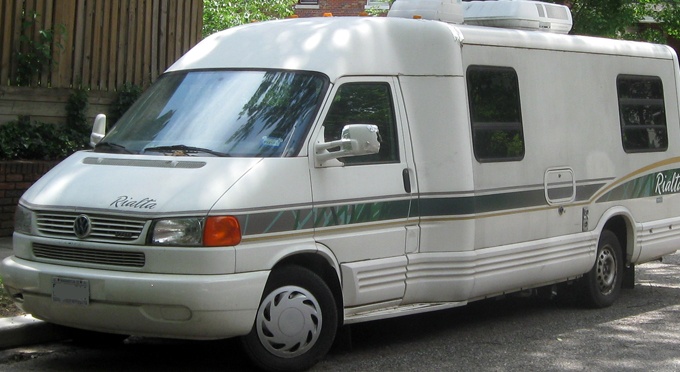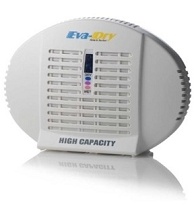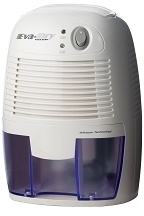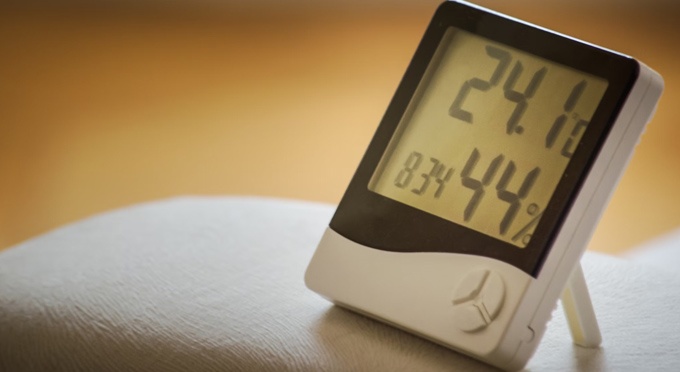 Is the inside of your RV a damp disaster full of mold and mildew? Hopefully not.
Is the inside of your RV a damp disaster full of mold and mildew? Hopefully not.
A musty smell is one of the first signs of an overly humid interior, and if you let it go, the problem will only get worse. When moisture is allowed to stay inside your motorhome or RV, mildew will begin growing to cause damage, create an unhealthy environment, and fill the cabin with even stinkier smells. Warmer climates are more prone to high humidity, but RV’s traveling in any climate can be susceptible to condensation and wet air. If these damp conditions are not corrected in one way or another, permanent damage will result, a gross stench will be inevitable, and if you’re really lucky, annoying pests like termites will start to think they’ve found the perfect home.
Whether your motorhome has moisture problems now, or if you just want to prevent them in the future, you should consider using a dehumidifier to eliminate excess moisture that accumulates, and keep your investment in pristine condition.
What is Humidity And Where Does It Come From?
In basic terms, humidity is moisture in the air.
When measuring humidity, there are three different methods to consider: specific, absolute, and relative. Specific humidity is determined by calculating the ratio of water vapor to air content on a mass basis. Relative humidity is the most common way to relate how humid the air is, and it is given as a percent. It’s the current absolute humidity relative to the maximum for any given temperature. To calculate absolute humidity, one would measure the grams per cubic meter of moisture in the air. For more information about humidity and water vapor, check out Wikipedia [1].
Outside humidity changes with weather conditions and geographical locations, but inside humidity can be affected by many other things. In small enclosed spaces like RV’s, simple activities like breathing at night, cooking food, or taking a shower can elevate moisture levels significantly. When outside temperatures drop overnight, and inside temperatures remain constant, little water droplets will begin to collect on windows and other locations.
Steam from a bathroom or kitchen can add more water droplets to quickly compound the problem. Good ventilation can help with some of this, but depending on the activities that take place, and the frequency thereof, some amount of excess humidity is almost guaranteed inside your motorhome.
Why Use A Dehumidifier?
No amount of driving with the windows down, sleeping with the vents open, or wiping wet walls with a towel will resolve moisture problems inside your RV. If you’re not proactive abount decreasing humidity in the air, long term problems will occur, and they include body damage, destruction of belongings, and mold and bacteria growth on upholstery and other surfaces.
A dehumidifier is a set it and forget it solution to fluctuating dampness, and the right one can easily regulate moisture inside you RV to create a safer, healthier, and more enjoyable climate with little effort.
- Simple: No complicated controls to learn, or difficult steps to take, anyone can operate and benefit from one of these easy-to-use devices. For most units, once you turn them on, you never have to do anything but empty the reservoir once it’s full.
- Effective: For the cost, these devices give you incredible peace of mind, and protection for your investment. Once you have one inside, it will almost immediately lower the humidity, and as long as you keep it running, it will maintain a comfortable climate for as long as you need it to.
- Portable: As long as you choose the right model, it will be easy to take with you, and easy to move around inside to keep it where it’s needed. Most machines are pretty light, but certain ones are incredibly compact and lightweight to make portability even easier.
What Does A Dehumidifier Do?
When placed inside your motorhome or RV, a dehumidifier will circulate air to pull out water without changing the temperature. Wet air enters the device, some of the moisture is extracted and collected, and then dry air exits to continue circulating inside your RV. After running for a period of time, the surrounding environment will be dry, and you won’t have to worry about wet walls and windows, pesky insects, or moisture damage that develops over time. As an added bonus, the interior will smell naturally fresh and you can be confident that you’re traveling in a clean and healthy space.
How Much Moisture Can It Collect?
Size and type of dehumidifier will determine how much moisture can be eliminated in a given amount of time, and as with anything, there are up-sides and down-sides, depending on which type of dehumidifier you choose. That large clunky machine sitting in your basement is ideal where it sits, but dragging it with you on your next vacation is probably not the best idea. For an RV, you’ll want a unit that is efficient, but you’ll also want one that’s small and quiet so it can operate unnoticed.
The amount of moisture eliminated in a given amount of time will be a key factor in deciding which dehumidifier is the perfect choice for you, so be sure to check the rating on any unit you’re looking at. For RV’s and motorhomes, there will be other factors that are aslo important, so depending on your exact needs, you’ll also want to consider size, noise level, durability, and whether or not it runs on electricity.
What’s The Best Dehumidifier For An RV?
Glad you asked. When choosing a unit for your RV or motorhome, you’ll want to select one that has a capacity that is high enough to get the job done, but you’ll also want one that’s small enough to fit in the limited space you have, and one that doesn’t have a noisy compressor to irritate you.
There are models that work without electricity, and those will offer silent operation with a lower capacity to remove moisture, but you can also get an electric one with a higher capacity that does not use a compressor to pull out the water. Dehumidifiers that utilize Peltier thermal technology can be just as effective as those with compressors, and power consumption is low, but they are much more quiet in comparison.
E-500 Mini Dehumidifier
 This compact unit is totally wireless, and requires no electricity or batteries to operate. It has special silica gel crystals inside that soak up moisture like a sponge. They will be blue in color when dry, and once they have soaked up a full 8-10 ounces of moisture, they will turn pink. Air in the room will flow freely through the exterior vents to pass by the crystals, and as they make contact, moisture will be extracted as dry air flows back out.
This compact unit is totally wireless, and requires no electricity or batteries to operate. It has special silica gel crystals inside that soak up moisture like a sponge. They will be blue in color when dry, and once they have soaked up a full 8-10 ounces of moisture, they will turn pink. Air in the room will flow freely through the exterior vents to pass by the crystals, and as they make contact, moisture will be extracted as dry air flows back out.
Once it reaches capacity, it can be recharged by plugging it into a standard electrical outlet. After sitting overnight, it will be ready to go again the next day. Use it over and over again as the perfect solution to small space moisture problems. The small size allows for an infinite number of placement options, but if you have a larger RV, you may need more than one to get the results you want. Place one in the kitchen area and one in the bathroom, or stick one at the front, and one at the back. Once exposed to moist air, it will immediately begin working to dry it out. More Info [2]
EDV-1100 Petite Dehumidifier
 With a power rating of only 22.5 W this model is able to eliminate up to 8 ounces of moisture per day, and it’s almost totally silent while running. At this capacity and power rating, it’s perfect for most RV’s and motor homes, and thanks to the small size, you tuck it almost anywhere without losing effectiveness. It does require electricity to operate, but a 12 volt adapter is available if necessary.
With a power rating of only 22.5 W this model is able to eliminate up to 8 ounces of moisture per day, and it’s almost totally silent while running. At this capacity and power rating, it’s perfect for most RV’s and motor homes, and thanks to the small size, you tuck it almost anywhere without losing effectiveness. It does require electricity to operate, but a 12 volt adapter is available if necessary.
Once running, a fan will help to circulate air as Peltier technology eliminates the water in it. Moisture will collect conveniently in the 16 oz reservoir at the front, so you can empty it easily once it gets full. Thanks to the automatic shut off, it will never run when it needs to be emptied, and because it has an indicator light that illuminates, you’ll never have to guess when it’s full. It’s rated to handle up to 1100 cubic feet, so despite it’s compact size, it offers plenty of power for most recreational vehicles. More Info [3]
Any dehumidifier would make a big difference in the comfort level of you RV, but the ones listed above are ideal thanks to efficient operation, low levels of noise, and compact sizing. You can certainly use a bigger machine, or one that is louder, but why would you want to solve one problem by creating another?
Excess moisture can certainly destroy the atmosphere in your motorhome, but loud machines and bulky spectacles can be just as destructive in their own way. One thing is for sure, if you have condensation problems or a musty odor, there is no better way to make it go away than a dehumidifier.
Where’s The Best Location?
Placement is important, but not essential. You should use the dehumidifier near where moisture is created, but you should also keep it out of the way, and away from children and pets that may decide to “play” with it. Ones with fans will circulate enough air to work in large areas, whereas smaller units without fans will only dry the air immediately surrounding them.
If you’re using a noisy machine, you may want to locate it as far away from listening ears and conversing mouths as possible, but if you are using a model with no fan, you may want it right next to you.
Should You Keep It Running At All Times? What About Storage?
Humidity can be a problem during long term storage, but most dehumidifiers should only be running when the RV is in use. While you are using your RV, you can pretty much keep the dehumidifier running at all times, but for storage, one that runs on electricity would not be a good choice.
You can place wireless dehumidifier models inside your motorhome or RV for storage, but remember that they have limited capacity, so you may need several depending on how long the vehicle will be stored. When choosing a storage location, interior garage locations will be less humid when compared to outdoor options, so you may want to choose something inside if dampness has been a problem in the past.
If You Measure, You Know.
Beyond adding a dehumidifier, you might consider a hygrometer to monitor and measure humidity in real time. These devices will let you know when a dehumidifier is necessary, and they will also let you know if the device you are using to combat the moisture is working or not. Essentially, it is just a basic instrument that will measure moisture in the environment so you can monitor levels, be alert of changes, and attempt to maintain an optimal level.

Other Ways To Reduce Moisture Inside Your Motorhome or RV
Excess moisture in a motorhome or RV can lead to issues like mold, mildew, and unpleasant odors. To reduce moisture levels and maintain a comfortable and healthy living environment you could start using a dehumidifier, or you could consider implementing one or more of these other strategies:
- Ventilation: Ventilation is one of the most effective ways to reduce moisture. Open windows and roof vents to allow fresh air to circulate through the vehicle. Installing vent covers can help keep vents open even in rainy weather.
- Use Exhaust Fans: Turn on exhaust fans in the bathroom and kitchen while cooking, showering, or whenever excess moisture is produced. This helps expel humid air outside.
- Moisture Absorbers: Use moisture-absorbing products like desiccant bags or containers filled with moisture-absorbing crystals. These can be placed in various areas of the RV, such as closets, cabinets, and the bathroom.
- Seal Leaks: Check for and repair any leaks or areas where water can enter the RV. Leaks can contribute significantly to moisture problems.
- Insulate and Ventilate: Insulate your RV properly to prevent condensation on cold surfaces. Proper insulation can also help maintain a more consistent interior temperature, reducing the likelihood of moisture buildup.
- Drip Pans: Use drip pans or trays under potted plants or other sources of moisture to catch excess water.
- Use Moisture-Resistant Materials: When renovating or making upgrades to your RV, consider using moisture-resistant materials for walls, ceilings, and floors. These materials are less prone to mold and mildew growth.
- Temperature Control: Maintain a comfortable interior temperature. Avoid extreme temperature differences between the inside and outside of the RV, as this can lead to condensation on surfaces.
- Check for Plumbing Leaks: Regularly inspect your RV’s plumbing system for leaks. Fix any leaks promptly to prevent water from accumulating inside the vehicle.
- Reduce Indoor Activities: Limit activities that generate moisture inside the RV, such as boiling water or drying wet clothes. If possible, perform these activities outside.
- Use Moisture-Resistant Bedding: Choose bedding materials that are moisture-resistant, as mattresses and bedding can be vulnerable to moisture accumulation.
- Maintain Proper Hygiene: Ensure that shower curtains are fully closed during showers to prevent water from escaping onto the bathroom floor. Squeegee the shower walls afterward to remove excess water.
- Store Wet Gear Outside: Keep wet gear like raincoats, umbrellas, or muddy shoes outside the RV to prevent excess moisture from entering.
By implementing these strategies, you can significantly reduce moisture levels in your motorhome or RV, creating a more comfortable and healthy living environment while preventing potential damage caused by excess moisture.
Don’t let your beautiful motor home get destroyed by the environment, but don’t limit yourself either. Any climate or location will be a viable destination once you have the perfect dehumidifier on board.
Have a specific model Dehumidifier that you would recommend to others? Use the comments box to share with everyone else.
Know about a way to reduce moisture that we didn’t list? Feel free to share your RV moisture reduction tips and tricks in the comments section below.
4 Comments To "The Perfect Dehumidifier For RV’s and Motorhomes"
#1 Comment By Barbara On 08/25/2015 @ 6:53 AM
I tried the E-500, i think it work better than the bigger, because it’s portable and you can easy to setup anywhere in your RV, you can use 2 dehumidifiers for better work than use the bigger that can broke anytime.
#2 Comment By SimplyGoodStuff On 09/03/2015 @ 12:10 PM
Yeah. A lot of people like that little guy. Totally silent, easy to hide, decent capacity, the list goes on. Thanks for the feedback Barbara.
#3 Comment By swirly On 01/24/2016 @ 6:04 PM
These Types may be just fine for use in an rv that only has 1 person, and that person does not spend much time in their rv, has no animals, does not do any cooking, does not use their showers, does not use a washer dryer, and one that stays put in a dry to very dry climate. Other than that a condenser type is definetly the only way to control it. These would be nice if they worked in most rv situations, but unfortunately they are more of an ideal item than a realistic option for keeping the humidity down in an rv.
We have tried both of these models above as well as those kind you hang in your closet ect…
In the end it was a condenser type that got the job done.
We are family of 3 Full Time Living, 2 bedroom 1 bath 5th wheel, washer/dryer, full shower, cook daily, no animals, 2004 Fleetwood Wilderness AX6 Advantage ,36.5 feet long with 4 slides, 2 AC units with Dry Mode that can reduce to 60% humidity, living in the desert.
To each their own, however we intend to take care of our unit and would like it to last us a good long while.
You cant see the mold behind the walls, you cant see the damage being done until you see it building up on your windows, by then you are approaching 80% and higher. 45% in an Rv is the cutoff for whence mold and other things start to grow in your walls.
To each their own, you pay now or you pay later but you always pay sometime.
#4 Comment By Annette J. Gordon On 03/08/2016 @ 4:53 AM
Great post. Which manufacturer/model would you recommend the most? I’m looking for best dehumidifier for bathroom…